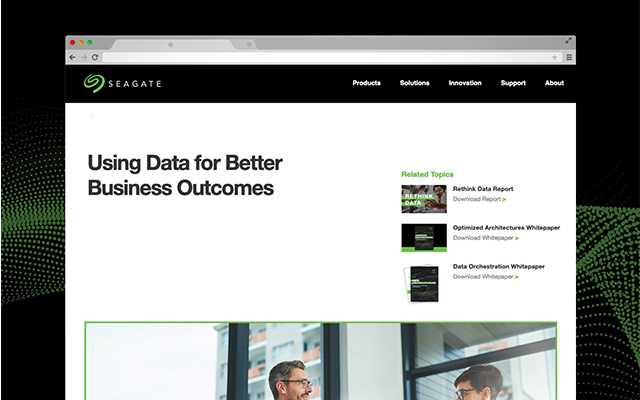How Data Can Help Increase Customer Satisfaction and Profit
Every business is a data business. According to a recently released report from Seagate, Rethink Data, enterprises will experience a 42.2% average annual increase in the volume of data generated over the next two years.
This growth will increase the sheer volume of data that businesses must manage. At the same time, data sprawl means information is now spread far and wide across every corner of the enterprise’s operations—from endpoints to the edge to the cloud.
Enterprises that use and collect lots of information already have more data in more places than they know what to do with. From manufacturing machinery and sensors embedded into products, a torrent of data must be collected, analyzed, and sent back and forth between the edge and the core network. In fact, the amount of new data created each year is projected to increase by a compound annual growth rate of about 26% between 2015 and 2025, reaching 175.8 zettabytes of new data by 2025. A zettabyte is one sextillion, or 1021. That's a lot of data.
Turning Data into Dollars
While IT leaders are rightly focused on the challenges of managing all this data, enterprises also need to understand the new business opportunities this influx of information represents. The more they can figure out new ways to leverage their data, the greater these insights will translate into increased revenue and profits.
The Rethink Data report shows that organizations are currently putting just 32% of their data to work. With most data going unleveraged, companies must do more than find new information sources to drive better business outcomes. More importantly, they must improve their ability to harness the data they're already collecting.
A recent report by McKinsey corroborates the findings in Seagate’s Rethink Data report, noting that harnessing data is a top concern for not only CIOs, but also their CEOs. When asked about their CEOs’ top priorities, 88% of CIOs pointed to revenue acceleration, while 71% said improved agility and faster time to market. “IT strategy has long been part of business strategy, but C-suite executives are increasingly seeking a larger impact from investments in digital technologies," the McKinsey report states. “Digital innovation has become central to the full range of business transformation initiatives and is no longer just one category among many."
Measurably Better Business Outcomes
Among the types of business outcomes enterprises can achieve by rethinking data are increased revenue, improved profit margins, bettr customer satisfaction, and more loyalty. However, there’s a range of success metrics that improved data management and analytics can provide.
For example, improving access to and use of data can increase employee productivity, which in turn improves employee retention while helping to lower costs. It can also reduce time to market for new products and services, which makes it easier to be responsive to the needs of consumers while helping to optimize acquisition strategies.
Businesses should implement a DataOps approach to connecting consumers and data creators so organizations can experience measurably better business outcomes. The more organizations can improve their data management and analytics, the faster they can use that information to gain a competitive advantage.
DataOps is the key to a data management strategy that enables companies to get more use out of their data, helping to boost customer satisfaction and profit. The easier it is to transfer data back and forth and interconnect it together, the greater the insights an organization can unlock.
Humans Asking the Right Questions
It takes technology like analytics-enabled data orchestration and a well-functioning data architecture to institute DataOps. However, a successful approach that will drive profit depends equally on people. The decisions an organization's teams make about data governance and processes will have an outsized impact on the company's ability to access and leverage data.
Start by asking questions about the organization's goals so everyone can understand if and how data is currently structured to help the organization meet them. For the goals of customer satisfaction and increased profit, an organization must know:
- Who has access to what data?
- How is the data classified?
- Which data is kept, and where?
- What is done with data after it is analyzed?
- How is data made available to business users and IoT endpoints?
- How can data be interconnected?
As an organization begins to ask these questions, it may learn that it doesn't know what it doesn't know. Therefore, business decision-makers, IT leaders, and data managers must work as one to understand what type of intelligence the organization needs to get out of its data. This collaboration will allow the team to collect and extract data efficiently and effectively without drowning everyone in a firehose of irrelevant information. The trick isn't to provide every user with full access to 100% of the data, but to provide the right people with the right data at the right time so they can make smarter decisions.
By analyzing and tracking curated data, optimal solutions can be created. The result of a successful DataOps approach is greater customer satisfaction thanks to better quality products that are delivered to market faster. This, in turn, leads to increased revenue, higher retention, and higher profits.
Download the full Rethink Data report to learn more about how enterprises are trying to use data to create better business outcomes.












